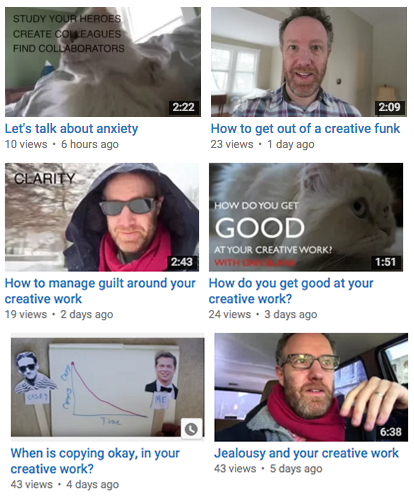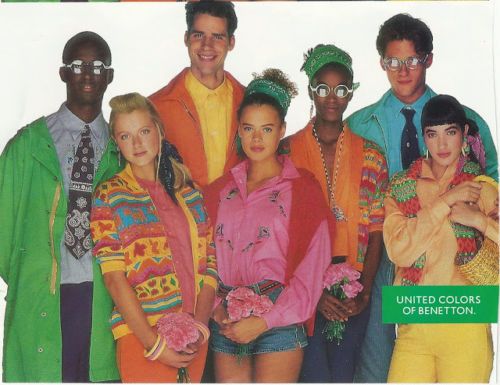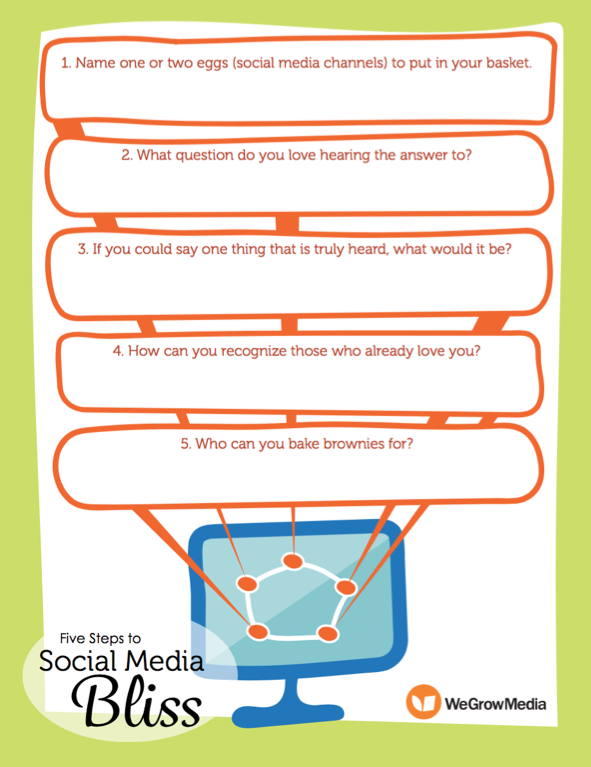When you release your work — your book, your art, your business — the biggest thing you fear is not failure, but silence.
That no one cared.
Deep down, you are certain that your work matters, that it can change people’s lives. But part of you resists being the one shouting from the rooftops about your work — you would prefer that other people doing that for you.
When others talk about how great your stuff is, it creates social proof, which is a key aspect of encouraging more sales. More on that below.
Today, I want to talk about specific tactics for getting reviews for your work. These are reviews that would appear on a retailer such as Amazon or Etsy. They are meant to help others make buying decisions, and it encourages the retailer itself to see that your work is popular, and therefore worthy of being promoted a bit more.
In the examples below, I’m going to use a sample context that assumes you are an author trying to get more reviews for your book on Amazon. But keep in mind, the same tactics apply to other creative work: art, a business, crafts, and so much else.
I also want to be clear: I am taking about reader reviews, or fan reviews. Yes, there are other types of reviews — media reviews, critic reviews, book blog reviews, review services, community reviews, etc. I’m not going to talk about those today. Those places are inundated with people pitching them books. Instead, I want to focus entirely on two aspects:
- Turning your fans into reviewers
- Getting more reviews that appear at the point of sale within an online retailer. I’m going to use Amazon as the stand in for online retailers here, but it applies to many other websites and industries.
Why? Because to me, focusing on reader reviews is timeless in terms of a long-term strategy of supporting your work. It also encourages great customers service practices to over-deliver to your readers. This is why I love how someone such as Amanda Palmer has found great success by focusing her love and attention on “her people,” those who love and support her work. (This is a blog post I wrote about her on that topic.) I’m less interested in analyzing services that work today, but may not work in 6 months, which keeps authors on a constant spin cycle of trying to follow the latest trend.
Okay, let’s dig in…
Social Proof Sells Your Work For You
I am always amazed at how many recently published books on Amazon have zero reviews. I mean, compare your gut reaction to three books on the same topic or genre that you are considering buying:
- Book A has zero reviews.
- Book B has 36 reviews.
- Book C has 142 reviews.
That is not to say that the number of reviews indicates which book is objectively better. It doesn’t. The book with zero reviews could be amazing.
But, when placed in the mode of where to invest your time and money, you may begin wondering, “If it’s so amazing, why is no one shouting about it?”
Let’s change the example. You are out on a date with your special someone. In front of you are three Italian restaurants. One is packed. One seems to have a healthy vibe with many of the tables filled, and one is empty. The waitstaff is just standing around, bored.
Which restaurant do you go into? Or rather, which do you cross off your list first?
Now let’s talk about your book. Imagine that the day you release your book, 25 reviews are posted. Wouldn’t that be great? To not sit there, refreshing Amazon, and seeing nothing but silence?
This is why whenever I see a new business owner obsessing over their logo, their business cards, their website, their brochures, I cringe. Sure, these things matter, but they pale in comparison to the value of social proof. To others talking about your work with enthusiasm. This, after all, is “word of mouth marketing,” which tends to be the only kind of marketing that is consistently effective.
We can see social proof around us in all kinds of subtle ways. When you are reading a blog, consider the difference between these two sentences:
- “Click here to see my best articles.”
- “Click here to read my most popular articles.”
The former indicates the stuff you hope I like. The latter, the stuff that everyone is actually talking about. Huge difference.
In the book Influence, Robert B. Cialdini lists social proof as a key aspect of marketing. He says that people are likely to rely on social proof when they are uncertain, so they tend to follow the lead of others who are similar to themselves. (If you are interested in marketing and haven’t read the book, order it right now. Seriously. See — social proof at work!)
Okay, okay, let’s talk about the nuts and bolts of getting reviews…
Focus People on Taking Actions that Matter
I’ll bet you have been overwhelmed with all the things you are told you have to do in order to promote your work. That you have to have a huge email list, a popular blog and podcast, and of course, loads of followers on every social media channel.
When considering your readers — think of actions that are truly meaningful. For instance, I go to a lot of author websites, and often find that they point me to 1,000 places at once. It’s not unusual for me to see a clutter of information, and links up top to seven or more social media feeds. This, despite the fact that they are only active on two of them. I mean, why send me to a Pinterest account that was last updated in 2013?
So often, we worry about being popular everywhere. “Follow me here, follow me there, follow me everywhere!!!!!”
Bleh.
Instead consider: what actions matter to your work? Put your reader’s focus there. My gut is that the list is pretty short. You hope people discover your work. That they buy it. That they love it. That they tell someone. That they become a fan.
Put your energy there. Brainstorm 1,000 creative ways to make those specific things happen.
This is what I loved about my experience in helping Sarah Towle successfully reach her $40,000 funding goal for her Kickstarter last year. Our goal was so specific, so we put months of creative thought into how to reach that singular goal. We went all in, and the focus allowed us to consider dozens of fun — and meaningful — ideas that leads to a huge goal.
Likewise, John Robin is an author in a Mastermind group that I run who is funding his book on a platform called Inkshares. The book doesn’t publish until later in 2016, and his singular focus is identifying loads of creative ways to get people to preorder.
So far he has 366 preorders for a book that isn’t even finished yet. Is John coasting on his credentials from previously published books? Nope, he’s a first time novelist. What’s more: since these folks are a part of the publishing journey, I’ll bet a sizable amount of them leave reviews in the first week. Can you imagine as a first time author, having 100 posted to Amazon in the week of release?
I would bet that this will be the reality for John.
So the first step to getting reviews is to identify a handful of key goals that matter for your work. If you want reader reviews, then prioritize them, and put real creative energy into considering how you can get them. Oh, let’s talk about that now…
You Have to Make the Ask
Too often, we assume that people will know how to support your work. We assume that they know to leave a review. Where to leave it. When to leave it.
They don’t.
You have to ask them to review you book.
You can do so in the obvious places: in your social media feeds, blog, newsletter, podcast, email, phone, in-person, billboards, telegrams, carrier pigeons… okay, yes, I’m getting carried away.
But also: in the book itself. It’s become common for an author to place their website at the end of the book, and promote other books. Encourage readers to leave a review as well.
Think of it this way: the reader just spent hours and hours with that book, with you whispering your story in their ear. That’s a very intimate thing. The moment they finish it, they are bursting with thoughts and emotions about the book. Give them an outlet for it.
I mean, can you imagine watching a movie you loved in a theater, and walking out into the lobby only to have the director and the star waiting for you, asking, “What did you think?”
Author Miranda Beverly-Whittemore sent a simple ask to her email list when she published a new short story:
“I sent an email out to my newsletter, saying there were ten copies of the short story available in exchange for an honest Amazon review in the next three days. We heard back from ten people within an hour.”
It’s worth noting that her email list is not huge, it’s a few hundred people. But… it’s a few hundreds of the right people, her biggest fans.
When making the ask to your reader don’t be boring about it — make it meaningful. People read as a way of experiencing, a way of crafting their own identity. Consider how you can encourage them to leave a review as a way that feels special to their needs. Perhaps you invite them to reach out to you after they leave a review. Tell them that you would love to read it. What reader wouldn’t want to be recognized by the author?
Feasibly, you could even offer them some kind of bonus. If they email you with a link to a review, you could give them a free short story, access to a fan program, another book, or simply a heartfelt thank you.
Now, some of you may be resisting in this moment. You may be thinking, “Dan, I’m a writer, and I’m an introvert. I don’t want to be emailing with readers.”
You, of course, get to choose that. You can choose every aspect of how you create and how you manage your career. But I obsess about actions that lead to meaningful success. I have been watching a wonderful interview series this week with musician G.E. Smith. After loads of stories of his success and the famous folks he has worked with, he was asked, “Do you have any regrets?” His response astounded me:
“Sure. Everything. EVERYTHING. I would have worked harder. I would have learned more. I would have been a better musician. The whole thing. But that’s balanced by all the great stuff too.”
The success he has had has given him a taste that if he had only tried harder, the sky was the limit. That video has 49 views on YouTube. I think all 49 of them are from me.
When I consider providing advice to you, this is what I keep in mind. That you can look back knowing that you did work that matters, and you didn’t leave opportunity untapped.
Don’t wait for others to take initiative. Ask for reviews.
Create an Action Team.
In the past I have written about the power of creating a “street team,” and that advice still holds. You may not call it that, but consider identifying a small group of folks who you know will take action to support your work.
This could be 5 people, it could be 100. The caveat is this: they must be on board to take actions.
I saw this recently with two examples. The first was an invitation from Michael Hyatt to join the launch team for the upcoming release of his new book. One of the bullet points: “leave a review on Amazon.”
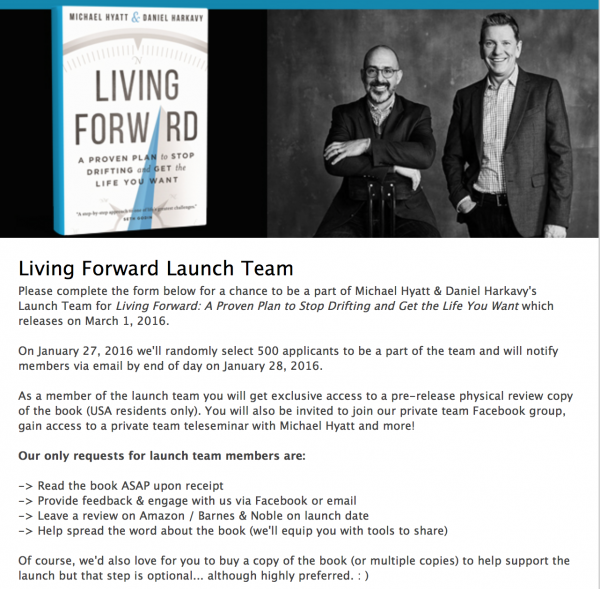
And another email I received from Jonathan Fields who is preparing a similar team for the launch of his upcoming book:
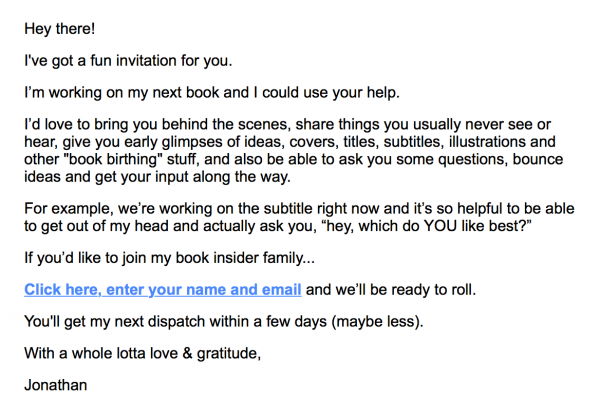
In trade, don’t think about the stuff you give members of your action team, instead consider the identity you can give them. You can make them feel like insiders. To give them access to you and behind the scenes to your success and make it feel as it is their own. To meet other super fans.
Give them what they want most: an identity they are proud of. Make them feel special, like an insider. This is the big secret of customer service and creating raving fans.
For instance: imagine you are invited to an early preview dinner at a new local restaurant that is about to open. This makes you feel special. You are one of the first to be invited in, and the general public can’t even access it yet! This isn’t about free food, but about the identity it gives you.
Incentivize People to Take Action
For those who are not in your inner circle, consider incentivizing people to take action by making them feel a part of the creative process. That buy supporting your work, they are supporting something that they believe in. In doing so, they are part of the creative process.
This is part of why we go to art galleries. Because it reflects on our own perception of our creativity.
Giving away books with the hopes of an honest review is a good strategy. But it is one of many.
Keep in mind that too many authors think that giving away a free copy is some kind of windfall to a potential reader. It is not always viewed that way by the recipient. The problem for most readers is not the price tag, but the TIME. How long does it take to read a book? 6-10 hours? People are swamped, and avid readers have a long list of books to read. So just giving away a book may not be enough.
Consider what else you can use to incentivize people to leave a review:
- Bonus content
- Fan club forums
- A coupon code
- Contests and prizes
Focus on Conversions — Ensuring Your Peeps Follow Through.
Create a communication system with would-be reviewers. Meaning, you set an expectation for when you will follow up with them. Why? Because this is common: people tell you “Oh, I will definitely leave a review!” And they never do.
This can happen for 1,000 reasons, but mostly because they are busy with other things. Perhaps they forget. They simply can’t prioritize it when you aren’t standing right in front of them.
The trick: this has to be a communication system. This is where the value of an email list comes in, or a thriving social media feed, or even just a well organized rolodex. (Remember those?)
This isn’t just around book launch either. You can set a schedule of every quarter, sending an email to your list asking them to leave a review for your book if they haven’t already.
This is something that many authors who want to jumpstart new life into an older book can consider. You could frame a new program around a book that you know people enjoy, but could reach more people. Make every aspect fun… make it about the reader and their experience/identity. Giveaways are just one of many tactics to get attention and build momentum.
Seed Reviews
Sometimes, readers simply don’t know how to write a decent book review. They freeze because they aren’t sure what to say. Whenever I see a rash of reviews for a book on Amazon that are light and vague, it pains me:
“Great characters, I was engaged the whole time!”
A review should be helpful to prospective readers. It is about encouraging honest feedback of your work in a way that encourages people to make good buying decisions.
When reaching out to fans and asking them to leave reviews, you can seed that request with ideas:
- An actual how-to
- With words or phrases
- Aspects of the book
- Questions to use as prompts
- Examples of great reviews
If you are working toward a book launch, begin to setup this process months before your book is released. Set a schedule, and encourage people to post them when it matters most near book launch.
Who will you ask?
How will you ask?
How will you follow up?
How will you use reviews?
Who can you get books to?
These are questions you don’t want to leave to the last minute.
What NOT To Do
Don’t pay for reader reviews.
Don’t try to game the system, and don’t overthink it. There are loads of articles about how Amazon culls reviews that it thinks are spammy or that the author orchestrated with close friends. A reactionary conclusion could be, “Never ask for reviews because Amazon will penalize you.” Keep in mind there is a natural way to do this, and an unnatural way. Amazon is looking for the unnatural way.
Focus on Timeless Practices, Not Fly-By-Night Trends
For this post, I didn’t want to give you any “will work today, but not tomorrow” tactics. Just good foundational practices.
A practice is something you can do every single month. Small ways that you avoid what I see most authors do: Make a huge rush to get 25 reviews in the first week their book comes out. But then, months and years later, not a single additional review is left. Their work doesn’t grow in influence, it languishes.
This is what I think about when I walk around a really good used bookstore. What I think about when I wander the stacks in a library: “Is this book relevant? Is it vibrant.”
In libraries and bookstores, you don’t always have indicators of this. The sales associate may be on the other side of the store. But online, we do have this context. Encouraging reviews is just good form — it illustrates that the book is alive in the hearts and minds of readers.
Caring is the Most Important Tactic Here
Publishing is a business. No, that business may not be your primary goal, but when we sell something on Amazon, it can’t be ignored that this is a retail experience.
One of my favorite quotes is this:
“Caring is a powerful business advantage.”
— Scott Johnson
Which means this: in a crowded marketplace, stand out by caring.
Be accessible to your readers. Thank them for anything they do to support your work, including the reviews they leave. This can happen in 1,000 subtle ways.
When my wife sells her art on Etsy, she includes extras in the package she mails: stickers, cards, and she hand-decorates the envelopes. This creates a personal connection.
If you are selling on Amazon, you don’t have that option, which is why it is so important to develop a platform where you can connect directly with your readers. This can be a newsletter, a Facebook group, or so much else.
People want to be recognized for their contributions. So often in life, we aren’t. Our efforts are overlooked. Be the person who doesn’t overlook that effort.
Send a thank you letter, a thank you email, or some other way of recognizing those who go out of their way to support your work with a review.
Use Reviews to Get More Reviews
I began this post by talking about the power of social proof. This applies here again — use the reviews you are getting as social proof to encourage more reviews.
Put them on your website, and anywhere your book description appears. If you have an email newsletter or active social media channels, put them there. Not in a spammy way, but in a caring and thankful way.
This is also a way to reward your reviewers by thanking them publicly.
You are modeling behavior for those who haven’t reviewed. “Do you want to support my work? Don’t just follow me on Twitter, review me on Amazon. Look at how Diana and Terry did it — aren’t they awesome?!”
Show readers that they have become part of a special insiders club by reviewing your books. That they have gone from “casual fan” to “super fan,” and that this helps shape their identity. That, by reviewing your work, they are true supporters of writing that they love. It is part of their creative process.
I didn’t expect this post to be nearly 3,500 words, and part of me feels as though I left so much out! Please let me know what I missed — what other tactics can one use to encourage reader reviews?
Thank you!
-Dan

